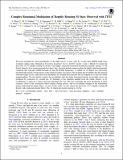| dc.contributor.author | Zhan, Zhuchang | |
| dc.contributor.author | Guenther, Maximilian N. | |
| dc.contributor.author | Rappaport, Saul A | |
| dc.contributor.author | Olah, K. | |
| dc.contributor.author | Levine, Alan M. | |
| dc.contributor.author | Winn, J. | |
| dc.contributor.author | Dai, F. | |
| dc.contributor.author | Zhou, G. | |
| dc.contributor.author | Huang, Chelsea | |
| dc.contributor.author | Bouma, L. G. | |
| dc.contributor.author | Ireland, M. J. | |
| dc.contributor.author | Ricker, George R. | |
| dc.contributor.author | Vanderspek, Roland K. | |
| dc.contributor.author | Latham, D. | |
| dc.contributor.author | Seager, Sara | |
| dc.contributor.author | Jenkins, J. | |
| dc.contributor.author | Caldwell, D. A. | |
| dc.contributor.author | Doty, J. P. | |
| dc.contributor.author | Essack, Zahra | |
| dc.contributor.author | Furesz, Gabor | |
| dc.contributor.author | Leidos, E. R. | |
| dc.contributor.author | Rowden, P. | |
| dc.contributor.author | Smith, J. C. | |
| dc.contributor.author | Stassun, K. G. | |
| dc.contributor.author | Vezie, Michael L. | |
| dc.date.accessioned | 2020-04-17T13:28:53Z | |
| dc.date.available | 2020-04-17T13:28:53Z | |
| dc.date.issued | 2019-05 | |
| dc.date.submitted | 2019-02 | |
| dc.identifier.issn | 1538-4357 | |
| dc.identifier.uri | https://hdl.handle.net/1721.1/124715 | |
| dc.description.abstract | We have searched for short periodicities in the light curves of stars with T eff cooler than 4000 K made from 2-minute cadence data obtained in Transiting Exoplanet Survey Satellite sectors 1 and 2. Herein we report the discovery of 10 rapidly rotating M dwarfs with highly structured rotational modulation patterns among 371 M dwarfs found to have rotation periods less than 1 day. Starspot models cannot explain the highly structured periodic variations that typically exhibit between 10 and 40 Fourier harmonics. A similar set of objects was previously reported following K2 observations of the Upper Scorpius association. We examine the possibility that the unusual structured light curves could stem from absorption by charged dust particles that are trapped in or near the stellar magnetosphere. We also briefly explore the possibilities that the sharp structured features in the light curves are produced by extinction by coronal gas, by beaming of the radiation emitted from the stellar surface, or by occultations of spots by a dusty ring that surrounds the star. The last is perhaps the most promising of these scenarios. Most of the structured rotators display flaring activity, and we investigate changes in the modulation pattern following the largest flares. As part of this study, we also report the discovery of 17 rapidly rotating M dwarfs with rotational periods below 4 hr, of which the shortest period is 1.63 hr. Key words: circumstellar matter – stars: flare – stars: low-mass – stars: pre-main sequence – stars: variables:
general – starspots | en_US |
| dc.language.iso | en | |
| dc.publisher | American Astronomical Society | en_US |
| dc.relation.isversionof | http://dx.doi.org/10.3847/1538-4357/AB158C | en_US |
| dc.rights | Article is made available in accordance with the publisher's policy and may be subject to US copyright law. Please refer to the publisher's site for terms of use. | en_US |
| dc.source | The American Astronomical Society | en_US |
| dc.title | Complex Rotational Modulation of Rapidly Rotating M Stars Observed with TESS | en_US |
| dc.type | Article | en_US |
| dc.identifier.citation | Zhan, Z., et al. “Complex Rotational Modulation of Rapidly Rotating M Stars Observed with TESS.” The Astrophysical Journal 876, 2 (May 2019): 127. © 2019 The American Astronomical Society | en_US |
| dc.contributor.department | Massachusetts Institute of Technology. Department of Earth, Atmospheric, and Planetary Sciences | en_US |
| dc.contributor.department | Massachusetts Institute of Technology. Department of Physics | en_US |
| dc.contributor.department | MIT Kavli Institute for Astrophysics and Space Research | en_US |
| dc.relation.journal | Astrophysical Journal | en_US |
| dc.eprint.version | Final published version | en_US |
| dc.type.uri | http://purl.org/eprint/type/JournalArticle | en_US |
| eprint.status | http://purl.org/eprint/status/PeerReviewed | en_US |
| dc.date.updated | 2020-04-13T14:30:46Z | |
| dspace.date.submission | 2020-04-13T14:30:49Z | |
| mit.journal.volume | 876 | en_US |
| mit.journal.issue | 2 | en_US |
| mit.license | PUBLISHER_POLICY | |
| mit.metadata.status | Complete | |
